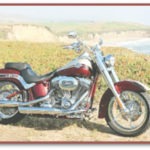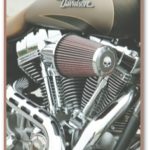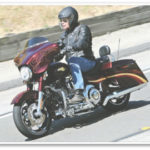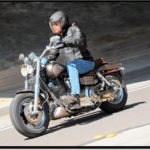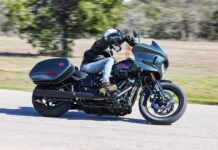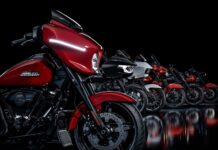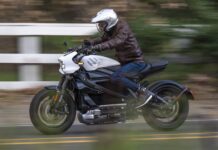Nothing but the best
Screw it, let’s ride… to the Ritz
Half Moon Bay, Calif., July 1—It’s hard not to read some symbolism into the Custom Vehicle Operations choice of the Ritz Carlton in this seaside hamlet as the setting for the roll-out of their 2010 model line-up. This is, after all, the swank resort best known in moto-circles as the host facility of the Legend of the Motorcycle Concours d’Elegance, the impressive exhibition of vintage and exotic machines that took place on these grounds annually for three years before falling victim to the sour economy and postponing the 2009 event—an event that was to have highlighted Indian as its featured marque. It’s hard not to imagine the swaggering carte-blanche crew of the CVO consciously seizing on that hiatus to stage a mini-concours of their own, and who can blame them? While not entirely insulated from the current industry malaise, the CVO—a.k.a. “Willie and the boys”—is a near-rogue division of The Motor Company that serves a hardcore, high-end consumer base largely distinct from the broader Milwaukee market. Their customers bleed the proverbial orange-and-black, and will generally forego lesser necessities like food, shelter and blood pressure medicine if those expenditures stand in the way of feeding their CVO bike habit.
It’s an enviable state of affairs on an otherwise embattled custom motorcycle landscape, and to feed the habit of the faithful for 2010, the CVO has introduced four fanciful new flavors of fix: the CVO Ultra, CVO Street Glide, CVO Fat Bob and the startling CVO Softail Convertible, all powered by the lusty 110-inch Twin Cam motor unique to CVO machines since 2007. This array of bikes fulfills the now-familiar CVO pattern of bringing forth each year (for the last four, anyway—a long time by CVO standards) one representative model from each of the three Big Twin platforms—the Dyna, Softail, and Tourer—in addition to the now-perennial CVO Ultra. Each model is created by a dedicated team of designers, and as you might expect, that creates a degree of sibling rivalry that has reliably served to keep the level of innovation and cosmetic wow-factor on each specimen dizzying. Thus, there’s a lot to talk about here for 2010, and we’ll start with the unquestioned flagship of the line, the CVO Ultra.
Gloat-boat redux
The CVO Ultra is putting in its fifth consecutive appearance in the CVO fold this year, and that’s not surprising inasmuch as this model has proven far and away the most popular CVO offering, and this despite being far and away the most expensive as well. The Ultra has a cult following all its own at this point—a sort of subsect of the broader CVO cult—and it consists of custom bagger fanciers who demand, in the words of CVO Ultra Team Manager Randy Riley, “the premiere American grand touring machine.” As such, the list of touring amenities and gadgetry boasted by the Ultra is exhaustive and includes things like an 80-watt audio system, CB/intercom, GPS system, ABS, cruise control, remote saddlebag/Tour Pak lock system, and onboard garage door opener. When those features are combined with that 110-inch mill, hydraulic clutch and the extensive roster of chassis and powertrain improvements brought to all of Milwaukee’s Tourers in 2009, you might reasonably ask what could possibly be added to the package for 2010. What do you give a bike that has everything?
As it turns out, the answer is: not much, really. But what they have added is well worth having, especially if your seating assignment plants you in the pillion position. Life on the road has always been sweet in that seat, and it just gets better, as the pampered Ultra passenger now has an adjustable lumbar support bar to lounge against, one that adjusts in and out by means of a knob on the armrest. The bar can also be adjusted for height, but that requires opening the Tour Pak lid, so you won’t be doing that operation on the fly. Other noteworthy touches this year include a new Tour Pak LED light panel to replace the previous incandescent unit, and besides looking really techno-cool, the new bar has a practical advantage in freeing up more space in the Tour Pak where the bulb fixtures used to protrude. There are also new LED pods positioned above the saddlebags to throw a light on the interiors.
The 2010 Ultra is priced at $35,999, and available in three breathless color schemes: Scarlet Red Pearl/Dark Slate, Riptide Blue/Titanium Dust, and Burnt Amber/Hot Citrus, and all are adorned with Flame Graphics.
Hybridized Glide
As we’ve mentioned, the current CVO model rotation demands one other Tourer in the line-up to keep the Ultra company, and the selection of the Street Glide for 2010 came as something of a surprise. It was a surprise because it took the place of last year’s Road Glide which, by CVO custom, should have returned for a second season. There’s that, but the greater surprise for us in the selection of the Street Glide for CVO treatment was that we’ve considered the stock OE Street Glide as already so customized—what with its package of custom controls and accessories, and its awesome CVO-ish rear fender replete with filler panels and LED light bands—as to be our nominee for least likely to get the CVO nod. We weren’t entirely squirrely in that view, as it turns out, since the new CVO Street Glide is not so much a Street Glide as a 2009 CVO Road Glide with a batwing fairing. This model has virtually all of the elements that distinguished that Road Glide, including that model’s rear fender and tail-dragger saddlebags—though the bags on the Street Glide are new one-piece versions providing more interior space and less cluttered lines. The bike also has 18-inch wheels front and back like the Road Glide had, the same passenger backrest, and—most tellingly—virtually the same Screamin’ Eagle paint motif.
Which is not to say that the CVO Street Glide didn’t get some novel goodies of its own. Most significantly, it received a new rear suspension setup. Instead of the familiar air shocks of the Tourer platform, there is a pair of hydraulic units, one of which is optimized for compression damping, and the other for rebound damping. What’s more, there is an adjustment knob on the left shock—accessible with the saddlebag removed—that allows you to set the suspension preload. The model also features a slammed and trimmed front fender that exposes more of the front wheel, which is definitely worth exposing. These dazzling wheels are chrome-on-black spinners dubbed Agitators, and described unblushingly by Team Manager Randy Klopfer as, “arguably, the finest wheels that Harley-Davidson has ever produced.” Who’s arguing?
The CVO Street Glide lists for $30,999. The paint schemes offered all-feature genuine Gold Leaf Graphics and with names like Candy Concord, Spiced Rum and Tequila Sunrise suggest that Klopfer’s team are the kind of guys we want to hang out with.
Fat Bob flourishes
The Fat Bob returns to the CVO roster for 2010, and this year has drawn the assignment of being the showcase vehicle for a number of exciting new CVO finishing techniques. That’s a plum assignment, too, given the CVO’s reputation in that department, and heading the list of innovations brought to the model is what they call the Midnight Pearl finish. This is a metal plating finish that we’re told has been under development for some period of time as the H-D engineers sought a process that would put down a tinted “black chrome” surface that met their standards of durability. It’s a gorgeous finish that has a sort of tarnished sterling silver appearance, and it’s been applied to a slew of the CVO Fat Bob’s most visible components—the fender struts, rear light bar, headlamp shells, horn cover, timer and derby covers, and the base of the tank console.
The Fat Bob’s new two-piece leather seat has a new finish technique as well—or, rather, a new lack-of-finish technique. The light brown leather used for the seat already has a distressed look, and since it lacks a leather-sealing coating to preserve its original appearance, it’s destined to “develop its own patina over time. That’s how Team Manager Bob Leroy put it, going on to compare that phenomenon with what happens to “your favorite pair of blue jeans.” The pillion portion of the affair is designed for quick-detachment, and once detached, reveals a pair of chrome/rubber strips that serve to protect the fender’s paint from both the pillion, and from whatever you might bungee back there in its absence.
One other finishing innovation used on some of the CVO Fat Bobs—the ones with the Satin Pewter with Sandstone Grind color option, to be exact—is a clear powder coat applied to the bare metal frame that lets all the raw beauty of weld beads and heat discoloration shine through. It’s a striking effect.
In keeping with the Fat Bob’s essential industrial-strength, bare-knuckled back-road brawler persona, the CVO version is accessorized with a Diamond Black collection of steel mesh-appearing parts including the footpegs, hand grips, shifter and brake pedal. The same Diamond Black pattern adorns the gauge faces.
Pricewise, the CVO Fat Bob stakes out the low end of the CVO range at $25,299, and besides the aforementioned Satin Pewter with Sandstone Grind color scheme, is offered in Cryptic Black and Opal Blue, both with Hellfire Flames. (But buy a Satin Pewter job. It’s a positively unique mind-blower.)
Softail stripper
In the course of its 11-year existence, the CVO has covered a lot of ground, offering up an impressive assortment of uber-customized machinery and dabbling at one time or another in a wide variety of specimens from every Harley-Davidson OE platform, save the Sportster platform. They haven’t gone there yet. And another place they hadn’t gone was the creation of a uniquely-CVO model entirely distinct from Milwaukee’s core contingent, but that’s changed for 2010 with the surprise introduction of the CVO Softail Convertible. This versatile custom creation is equally noteworthy for its practical-minded utility, which is a quality that’s never been an overriding design priority of the CVO, to say the very least.
The “Convertible” nomenclature itself is nothing new, having been applied for a decade from 1989 to 1999 to both FXRS and FXD models to describe their quick-change ability to go from bagged-and-screened sport-tourer to stripped-down sport-cruiser. The twofer appeal of those models was limited in an era when Harley consumer preference was decidedly biased towards flash value over utilitarian virtue, and the concept was abandoned. In resurrecting the concept, the CVO gave it a new twist by applying it to a Softail chassis for the first time, and going a giant step farther by creating a distinct new Softail model for the purpose, one that has no counterpart in the Harley OE collection.
The CVO Softail Convertible’s complement of quick-detach components consists of a modest fairing with a color-matched lower panel and smoked windscreen, a set of leather-covered saddlebags, a low passenger backrest, and a removable pillion that, once removed, reveals a pair of those chrome/rubber rails we saw on the CVO Fat Bob. These components constitute the touring side of the Convertible formula, and the fairing provides a reasonable level of wind protection, the bags offer some reasonable packing capacity, and the pillion/backrest provide for decent passenger comfort and security. More importantly, for styling purposes, they’re so well-integrated visually as to give not a hint of the model’s barhopper alter ego. But the transformation to that role is a snap, and after demonstrating the quick-change act for the assembled press, Team Manager Jeff Smith summed up the procedure nicely, noting, “In less than two minutes, no tools required, we’ve gone from a bona fide touring-capable vehicle to an extremely clean-looking custom cruiser.”
It’s clean, all right. And it’s also truly unique. While its FL Softail source code is undeniable, it defies direct comparison to anything that’s been produced with the FLST prefix. Distancing it from anything that’s come before are, for starters, the unprecedented 18-inch wheel dimension, and the stunning swept-spoke “Stinger” wheels, sprocket and rotors employed here. (And in answer to our earlier question about who would argue with Randy Klopfer’s assertion that the Agitator wheels on the CVO Street Glide were H-D’s finest ever, well, that would be Jeff.) The fenders take it from there, with the front one being the same slammed-and-trimmed unit used on the Street Glide, and the rear fender being a hella-fat new full coverage piece in “traditional FL style.” The Convertible’s rear suspension is lowered, and in concert with the skinny leather operator seat, lowers the seat height to 24.4 inches—one of Milwaukee’s lowest perches. Also setting the Convertible apart is its elimination of a conventional taillight fixture in favor of a combo brake/indicator/ running light system housed in the turn signal pods.
And there’s more. The Convertible’s speedometer is a digital read-out unit that takes the squint work out of checking your speed—it’s right there in big numbers. That speed read-out is centered in a perimeter-sweep analog tachometer—meaning there’s no needle here, just a pointer poking in from the perimeter at a rev number on the dial. Takes some getting used to, it does.
And lastly, but not leastly—at least not for us—the Convertible is the first FL in memory to eschew that damned heel shifter above the footboard that nobody but motor cops with their shiny shoes ever asked for, and that has plagued any civilian FL operator with a shoe size he’s happy to admit. There’s just a toe shifter on this model. And a handsome chrome cap where the heel shifter would be, were there one. Nice. Smart.
The Convertible team has done a bang-up job on this bike, but they did blow it in one tiny particular. When the quick-detach touring components are removed from the bike, they leave the rubber-grommeted docking points exposed, which detracts from the bike’s clean custom appearance. They ain’t pretty, and you can fix that ugly with a set of the magnetic chrome vanity caps offered in H-D’s P&A catalogue, but for the list price of $27,999, the Convertible should come with that finishing touch included.
Color options include Inferno Orange/Vivid Black and Abyss Blue/Sapphire—both with Silver Braze Graphics—and Crimson Red Sunglo/Autumn Haze with Black Candy Grind.


